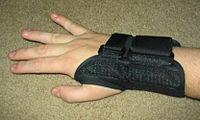
Photo from wikipedia
BACKGROUND Office workers have the highest incidence of neck pain of all occupations. However, the relationship between symptoms and the risk factors is unclear. OBJECTIVE To examine the relationship between… Click to show full abstract
BACKGROUND Office workers have the highest incidence of neck pain of all occupations. However, the relationship between symptoms and the risk factors is unclear. OBJECTIVE To examine the relationship between self-reported neck pain with a comprehensive range of individual and work-related risk factors. METHODS This study utilised a cross-sectional study design. Office workers with and without neck pain (n=763) were recruited. Participants completed a survey which included a Pain Numerical Rating Scale (dependent variable), and measures of independent variables including demographic, individual, work-related factors, neck/shoulder muscle strength, endurance, and range of motion (ROM). The relationships between the independent and dependent variables were analysed in a logistic regression model. RESULTS Neck pain was significantly associated with more senior occupational categories, working more than six hours per day on the computer, female sex, greater fear avoidance beliefs for work, greater psychological distress, and reduced cervical flexion ROM. The low severity of neck pain of the participants in this study may limit a robust determination of their association with the risk factor variables, but the studied sample is a realistic representation of the office worker population. CONCLUSION Several potentially modifiable individual and work-related factors were identified to be associated with the presence of self-reported neck pain in office workers. Future studies will be needed to investigate whether strategies to alter these modifiable risk factors translate to changes in neck pain. TRIAL REGISTRATION ACTRN12612001154897 (https://www.anzctr.org.au/Trial/Registration/TrialReview.aspx?id=363209).
Journal Title: Brazilian journal of physical therapy
Year Published: 2018
Link to full text (if available)
Share on Social Media: Sign Up to like & get
recommendations!